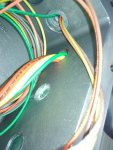You are using an out of date browser. It may not display this or other websites correctly.
You should upgrade or use an alternative browser.
You should upgrade or use an alternative browser.
Bushing for a Threaded Hole in an Enclosure
- Thread starter Jagnnm
- Start date
- Status
- Not open for further replies.
Coppersmith
Senior Member
- Location
- Tampa, FL, USA
- Occupation
- Electrical Contractor
Normally, boxes that have integral hubs have smooth surfaces where they enter the box. It's odd that yours do not. I see one of the conductor's is a #3, so a bushing would be required. I can't think of a better way (that is listed) than what you have suggested. A chase nipple topped by a plastic bushing. Obviously, you would have to de-terminate or cut the conductors to do this. Another way that isn't listed but would provide protection is to squirt some silicone into the hub and hold the conductors away from the sides while it hardens.
300.4(G) Insulated Fittings. Where raceways contain 4 AWG
or larger insulated circuit conductors, and these conductors
enter a cabinet, a box, an enclosure, or a raceway, the conductors
shall be protected by an identified fitting providing
a smoothly rounded insulating surface, unless the conductors
are separated from the fitting or raceway by identified
insulating material that is securely fastened in place.
Exception: Where threaded hubs or bosses that are an
integral part of a cabinet, box, enclosure, or raceway provide
a smoothly rounded or flared entry for conductors.
300.4(G) Insulated Fittings. Where raceways contain 4 AWG
or larger insulated circuit conductors, and these conductors
enter a cabinet, a box, an enclosure, or a raceway, the conductors
shall be protected by an identified fitting providing
a smoothly rounded insulating surface, unless the conductors
are separated from the fitting or raceway by identified
insulating material that is securely fastened in place.
Exception: Where threaded hubs or bosses that are an
integral part of a cabinet, box, enclosure, or raceway provide
a smoothly rounded or flared entry for conductors.
wwhitney
Senior Member
- Location
- Berkeley, CA
- Occupation
- Retired
How about a T&B Insuliner? Here's the 1/2", just increment the part number for larger sizes:
Not sure how they are held in place.
Cheers, Wayne
Not sure how they are held in place.
Cheers, Wayne
synchro
Senior Member
- Location
- Chicago, IL
- Occupation
- EE
I assume these threaded holes are NPT which would have a narrower diameter on the inside of the enclosure. If so then it's likely that you won't be able to screw in an NPS straight threaded chase nipple from the inside of the enclosure. But you can try it.
Forqnc
Member
- Location
- Elizabeth City, NC
- Occupation
- Electrical Controls Engineer
When we design our Nema 7 boxes, we have to specify thread type, so it could NPT or NPS depending on the designer.I assume these threaded holes are NPT which would have a narrower diameter on the inside of the enclosure. If so then it's likely that you won't be able to screw in an NPS straight threaded chase nipple from the inside of the enclosure. But you can try it.
The conduit hubs appear to be NPT and the optional device holes are NPS. So I would most likely not be able to use the chase nipple to correct the issue. Thanks for bringing this up. We will most likely have to use an insert like wwhitney suggested.
Thanks for all you support.
Regards,
Thanks for all you support.
Regards,
- Location
- Illinois
- Occupation
- retired electrician
It is required to be NPT if you want to comply with the NEC, assuming it is not metric.When we design our Nema 7 boxes, we have to specify thread type, so it could NPT or NPS depending on the designer.
500.8(E) Threading. The supply connection entry thread form shall be NPT or metric. ...
- Location
- Illinois
- Occupation
- retired electrician
I have never seen a tapped explosion proof box that had a smoothly rounded surface. If the hubs were cast into the box, then yes, but in this type of box where the holes can be tapped at many locations, all that I have seen look like the picture in this thread.Normally, boxes that have integral hubs have smooth surfaces where they enter the box. ...
It is required to be NPT if you want to comply with the NEC, assuming it is not metric.
What exactly is a “supply connection”?
We always specified NPS threads for NEMA 7 boxes used for control systems.
- Location
- Illinois
- Occupation
- retired electrician
I assume that the "supply connection" is the entry into the enclosure. it is my opinion that all threads used for any fittings in a Classified area must be NPT.What exactly is a “supply connection”?
We always specified NPS threads for NEMA 7 boxes used for control systems.
I looked at the spec sheets for 3 different brands of NEMA 7 enclosures and they all specify that the tapped holes be NPT.
One of them specified that for Groups B&C that the seal fitting be with in 1.5" of the enclosure. I don't think I have ever seen that spec before. That is much more restrictive than the code rule of within 18".
- Status
- Not open for further replies.



